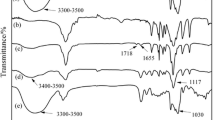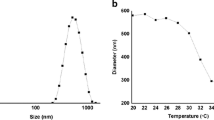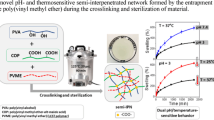Abstract
Poly(N-isopropylacrylamide) (NIPAAm)/polytetramethylene ether glycol (PTMEG) interpenetrating polymer networks (IPNs) were synthesized and their feasibility as thermosensitive hydrogels for drug release was investigated. The release of indomethacin incorporated into these matrices showed pulsatile patterns in response to temperature changes and was sensitive to a few degrees of temperature fluctuation. The temperature inducing on–off release deviated from the gel collapse temperature of unloaded gel, possibly because of solute effects on network properties. The lag time and release profile of indomethacin in the low-temperature region (on process) of each temperature cycle were affected by the gel composition and applied temperature. The results of this study demonstrate that solute release can be regulated by rapid deswelling of the surface of the gels in response to temperature.
Similar content being viewed by others
REFERENCES
S. W. Kim, R. V. Petersen, and J. Feijen. Polymeric drug delivery systems. In J. Ariens (ed.), Drug Design, Vol. X, Academic Press, New York, 1980, pp. 193–250.
J. Heller. Chemically self-regulated drug delivery systems. J. Control. Rel. 8:111–125 (1988).
S. Hirotsu, Y. Hirokawa, and T. Tanaka. Volume-phase transitions of ionized N-isopropylacrylamide gels. J. Chem. Phys. 87:1392–1359 (1987).
Y. Hirose, T. Amiya, Y. Hirokawa, and T. Tanaka. Phase transition of submicron gel beads. Macromol. 20:1342–1344 (1987).
S. Hirotsu. Critical points of the volume phase transition in N-isopropylacrylamide gels. J. Chem. Phys. 88:427–431 (1988).
E. S. Matsuo and T. Tanaka. Kinetics of discontinuous volume-phase transition of gels. J. Chem. Phys. 89:1695–1703 (1988).
R. E. S. Freitas and E. L. Cussler. Temperature sensitive gels as extraction solvents. Chem. Eng. Sci. 42:97–103 (1987).
A. S. Hoffman, A. Afrassiabi, and L. C. Dong. Thermally reversible hydrogels. II. Delivery and selective removal of substances from aqueous solutions. J. Control. Rel. 4:213–222 (1986).
Y. H. Bae, T. Okano, and S. W. Kim. Thermo-sensitive polymers as on-off switches for drug release. Makromol. Chem. Rapid Commun. 8:481–485 (1987).
T. G. Park and A. S. Hoffman. Effect of temperature cycling on the activity and productivity of immobilized galactosidase in a thermally reversible hydrogel beads reactor. Appl. Biochem. Biotech. 19:1–9 (1988).
C. A. Cole, S. M. Schreiner, J. H. Priest, N. Monji, and A. S. Hoffman. N-Isopropylacrylamide and N-acryloxysuccinimide copolymer. A thermally reversible, water soluble, activated polymer for protein conjugation. ACS Symp. Ser. 350:245–254 (1987).
Y. Okahata, H. Noguchi, and T. Seki. Thermoselective permeation from a polymer-grafted capsule membrane. Macromol. 19:493–494 (1986).
Y. Okahata, H. Lim, G. Nakamura, and S. Hachiya. A large nylon capsule coated with a synthetic bilayer membranes. Permeability control of NaCl by phase transition of the dialkylammonium bilayer coating. J. Am. Chem. Soc. 104:4855–4859 (1983).
D. A. Tirrel. Macromolecular switches for bilayer membranes. J. Control. Rel. 6:15–21 (1987).
S. Shinkai, S. Nakamura, K. Ohara, S. Tachiki, O. Manabe, and T. Kajiyama. “Complete” thermocontrol of ion permeation through ternary composite membranes composed of polymer/liquid/crystal/amphiphilic crown ehter. Macromol. 20:21–28 (1987).
Y. H. Bae, T. Okano, and S. W. Kim. “On-off” thermocontrol of solute transport. I. Temperature dependence of swelling of N-isopropylacrylamide networks modified with hydrophobic components in water. Pharm. Res. 8:531–537 (1991).
W. D. Rhine, D. S. T. Hsieh, and R. Langer. Polymers for sustained macromolecule release: Procedures to fabricate reproducible delivery systems and controlled release kinetics. J. Pharm. Sci. 69:265–270 (1980).
L. D. Taylor and L. D. Cerankowski. Preparation of films exhibiting a balanced temperature dependence to permeation by aqueous solution—A study of lower consolute behavior. J. Polym. Sci. Polym. Chem. Ed. 13:2511–2570 (1975).
Author information
Authors and Affiliations
Rights and permissions
About this article
Cite this article
Bae, Y.H., Okano, T. & Kirn, S.W. “On–Off“ Thermocontrol of Solute Transport. II. Solute Release from Thermosensitive Hydrogels. Pharm Res 8, 624–628 (1991). https://doi.org/10.1023/A:1015860824953
Issue Date:
DOI: https://doi.org/10.1023/A:1015860824953




